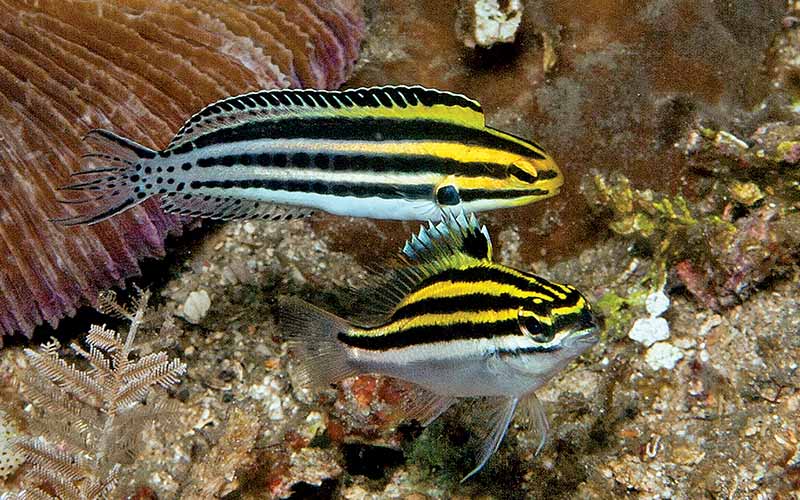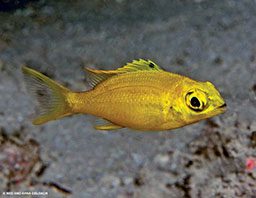I never gave much thought to fangblennies until one bared its fangs at my finger, which I’d placed imprudently close to a male guarding its nest. My hand snapped back as if I’d seen a snake. From a more respectful distance I watch the father-to-be glare at me from the open end of a tin can glistening with eggs. With a quick glance around it becomes clear that I am not the only one who has had a run-in with the formidable fangs: Not one of the numerous, forever-hungry wrasses buzzing about the bottom goes anywhere near the blenny’s tempting cache of fat-filled eggs.
The adaptation of fangs has been a game changer for 55 blenny species in six genera in the Indo-Pacific. Unlike their endlessly cute, unarmed cousins that must spend their lives close to hiding holes, sabertooth blennies (or fangblennies as they have come to be known) evolved into streamlined open-water swimmers able to keep predators at bay with the threat of weaponry. As if fangs didn’t provide protection enough, species in genus Meiacanthus won a second evolutionary jackpot: the ability to inject venom through a groove in their curved canines. This potent combination of adaptations provides such an advantage that over time a smattering of similar-sized reef fishes evolved to mimic several species of Meiacanthus. This charade, an example of Batesian mimicry, allows the impostor a bit more freedom from predation when feeding in the open.

Shortly after my fang encounter, Anna spots a juvenile bridled monocle bream hanging around a venomous fangblenny. The resemblance is uncanny. The mimic’s size, black stripes and yellow upper body match up well with the model. The little bream has even taken on the blenny’s herky-jerky swimming style.
After arriving home we contact longtime friend Bill Smith-Vaniz, an authority on the taxonomy and mimicry of fangblennies. His interest goes back to 1969 when as a graduate student he and his mentor, Victor Springer, Ph.D., a blenny man from the Smithsonian, traveled to the Gulf of Aqaba on a collecting trip. During the trip the pair decided to put three similar-looking blennies through a thorough test for mimicry. Their group of blue and yellow fishes consisted of a venomous Meiacanthus, the model; a nonvenomous fangblenny of genus Plagiotremus, which makes its living snipping scales off unsuspecting fishes; and a fangless bottom-dwelling Ecsenius.
The scientists first had to find out for certain if their model was actually toxic. Springer — well established, married and the father of two — deferred to Smith-Vaniz, who in the best tradition of young graduate students allowed a maddened Meiacanthus, fresh from the lab tank, to bite him on his bare midriff.
“Stung like a bee, I wouldn’t want to do it again,” he chuckles over the phone from his home in Gainesville, Fla. “The wound turned red and formed a welt that lasted most of the day. But it was worth it. There was no doubt our model was venomous. Tell you what, I’ll send you a set of my mimicry papers.”

Days later a bulging envelope arrives. Out spills several hours of serious reading. From the beginning it becomes clear that mimicry by natural selection is difficult to prove, requiring a lot more evidence than species simply looking alike. For starters, true mimics should regularly associate with their models, models are expected to be more abundant, and deception and benefit must be proven. Then there is something called geographic variation in appearance, which states that if there is a strong regional variation in the model’s appearance, this will be mirrored by the mimic.

On follow-up trips to the Gulf of Aqaba, Smith-Vaniz and Springer spent hours making observations underwater and hovering around aquariums with clipboards in hand. According to their co-authored paper, on their home turf the three blennies performed well, staying together 60 percent of the time in some combination or another. When offered up as food to a lionfish, a stonefish and a grouper in lab tanks, all the predators immediately spit out the venomous Meiacanthus, and from then on had little or nothing to do with blue and yellow fishes in general — the charade appears to be a win-win-win. By mimicking both the Meiacanthus and a defenseless algae-eating blenny, the scale-nipping Plagiotremus can more easily sneak up on prey. And the defenseless bottom-grazing Ecsenius can extend its feeding range by palling around with its model. At the same time the Meiacanthus’ warning colors get advertised broadly.
While diving in Fiji, thousands of miles from the Philippines, we find our juvenile monocle bream once again, but this time it’s completely yellow. It doesn’t take much scouting around to discover the reason — the local fanged Meiacanthus and Plagiotremus are also yellow, a strong case for mimicry if there ever was one.
© Alert Diver — Q4 Fall 2015